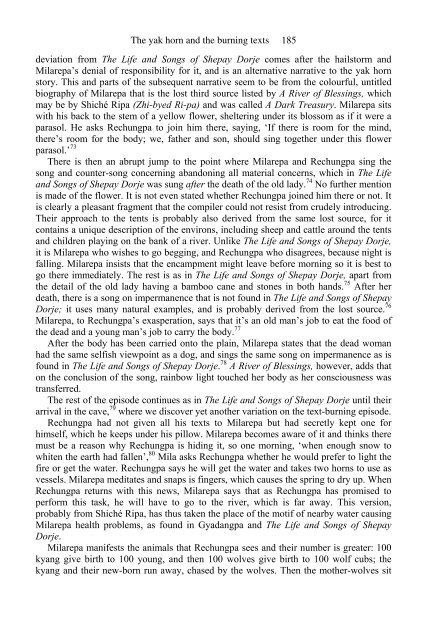The Biographies of Rechungpa: The Evolution of a Tibetan ...
The Biographies of Rechungpa: The Evolution of a Tibetan ...
The Biographies of Rechungpa: The Evolution of a Tibetan ...
You also want an ePaper? Increase the reach of your titles
YUMPU automatically turns print PDFs into web optimized ePapers that Google loves.
<strong>The</strong> yak horn and the burning texts 185<br />
deviation from <strong>The</strong> Life and Songs <strong>of</strong> Shepay Dorje comes after the hailstorm and<br />
Milarepa’s denial <strong>of</strong> responsibility for it, and is an alternative narrative to the yak horn<br />
story. This and parts <strong>of</strong> the subsequent narrative seem to be from the colourful, untitled<br />
biography <strong>of</strong> Milarepa that is the lost third source listed by A River <strong>of</strong> Blessings, which<br />
may be by Shiché Ripa (Zhi-byed Ri-pa) and was called A Dark Treasury. Milarepa sits<br />
with his back to the stem <strong>of</strong> a yellow flower, sheltering under its blossom as if it were a<br />
parasol. He asks <strong>Rechungpa</strong> to join him there, saying, ‘If there is room for the mind,<br />
there’s room for the body; we, father and son, should sing together under this flower<br />
parasol.’ 73<br />
<strong>The</strong>re is then an abrupt jump to the point where Milarepa and <strong>Rechungpa</strong> sing the<br />
song and counter-song concerning abandoning all material concerns, which in <strong>The</strong> Life<br />
and Songs <strong>of</strong> Shepay Dorje was sung after the death <strong>of</strong> the old lady. 74 No further mention<br />
is made <strong>of</strong> the flower. It is not even stated whether <strong>Rechungpa</strong> joined him there or not. It<br />
is clearly a pleasant fragment that the compiler could not resist from crudely introducing.<br />
<strong>The</strong>ir approach to the tents is probably also derived from the same lost source, for it<br />
contains a unique description <strong>of</strong> the environs, including sheep and cattle around the tents<br />
and children playing on the bank <strong>of</strong> a river. Unlike <strong>The</strong> Life and Songs <strong>of</strong> Shepay Dorje,<br />
it is Milarepa who wishes to go begging, and <strong>Rechungpa</strong> who disagrees, because night is<br />
falling. Milarepa insists that the encampment might leave before morning so it is best to<br />
go there immediately. <strong>The</strong> rest is as in <strong>The</strong> Life and Songs <strong>of</strong> Shepay Dorje, apart from<br />
the detail <strong>of</strong> the old lady having a bamboo cane and stones in both hands. 75 After her<br />
death, there is a song on impermanence that is not found in <strong>The</strong> Life and Songs <strong>of</strong> Shepay<br />
Dorje; it uses many natural examples, and is probably derived from the lost source. 76<br />
Milarepa, to <strong>Rechungpa</strong>’s exasperation, says that it’s an old man’s job to eat the food <strong>of</strong><br />
the dead and a young man’s job to carry the body. 77<br />
After the body has been carried onto the plain, Milarepa states that the dead woman<br />
had the same selfish viewpoint as a dog, and sings the same song on impermanence as is<br />
found in <strong>The</strong> Life and Songs <strong>of</strong> Shepay Dorje. 78 A River <strong>of</strong> Blessings, however, adds that<br />
on the conclusion <strong>of</strong> the song, rainbow light touched her body as her consciousness was<br />
transferred.<br />
<strong>The</strong> rest <strong>of</strong> the episode continues as in <strong>The</strong> Life and Songs <strong>of</strong> Shepay Dorje until their<br />
arrival in the cave, 79 where we discover yet another variation on the text-burning episode.<br />
<strong>Rechungpa</strong> had not given all his texts to Milarepa but had secretly kept one for<br />
himself, which he keeps under his pillow. Milarepa becomes aware <strong>of</strong> it and thinks there<br />
must be a reason why <strong>Rechungpa</strong> is hiding it, so one morning, ‘when enough snow to<br />
whiten the earth had fallen’, 80 Mila asks <strong>Rechungpa</strong> whether he would prefer to light the<br />
fire or get the water. <strong>Rechungpa</strong> says he will get the water and takes two horns to use as<br />
vessels. Milarepa meditates and snaps is fingers, which causes the spring to dry up. When<br />
<strong>Rechungpa</strong> returns with this news, Milarepa says that as <strong>Rechungpa</strong> has promised to<br />
perform this task, he will have to go to the river, which is far away. This version,<br />
probably from Shiché Ripa, has thus taken the place <strong>of</strong> the motif <strong>of</strong> nearby water causing<br />
Milarepa health problems, as found in Gyadangpa and <strong>The</strong> Life and Songs <strong>of</strong> Shepay<br />
Dorje.<br />
Milarepa manifests the animals that <strong>Rechungpa</strong> sees and their number is greater: 100<br />
kyang give birth to 100 young, and then 100 wolves give birth to 100 wolf cubs; the<br />
kyang and their new-born run away, chased by the wolves. <strong>The</strong>n the mother-wolves sit











